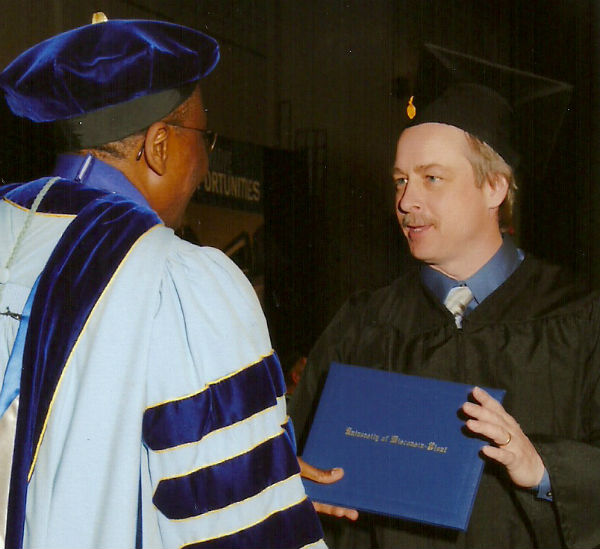Editor’s note: Peter is now a senior biotech production specialist at Regeneron.
After seeing his workplace flooded with three inches of antifreeze, Peter Flannery of Clifton Park, New York decided something needed to change. Several years later, after completing a Universities of Wisconsin Bachelor of Science in Sustainable Management degree, Flannery says his life is, literally, rooted in sustainability.
Road to sustainable management
Prior to earning his online degree, Flannery worked at an auto plant for nearly 20 years. He saw interest in sustainable operations grow in the automotive industry, but, he says, “As in most of the world, profit comes first. You can’t stay in business unless you’re viable.”
It was a major glycol system accident at the plant in 2003 that brought his thoughts on sustainability to a head. The disaster left the plant covered in antifreeze and the company reeling. “After the costly cleanup, their response was to shut off the glycol system and replace it with running city water,” says Flannery.
This presented two problems: running water is expensive, and the wastewater was dumped into Lake Michigan. Though it didn’t contain pollutants, the wastewater raised the temperature of the lake, endangering natural inhabitants.
“It became less about money and more about finding a company focused on sustainable practices.”
Concerned about the effects on the surrounding ecosystem, Flannery investigated sustainable practices over the next few years. The plant shut down in 2010, but a new opportunity appeared with the passage of the Trade Adjustment Assistance Extension Act of 2011—the opportunity to go back to school.
“That’s a big decision when you’re 45 years old,” Flannery says. But he took the plunge, enrolling in the UW Sustainable Management program.
Get Program Guide
Learn more about our 100% online degree and certificate programs.
A sustainability degree program that ignites passion
 “My intention was to get a degree and a higher-paying job,” Flannery explains. “But as I learned about sustainability and systems thinking, my priorities changed. It became less about money and more about finding a company focused on sustainable practices.”
“My intention was to get a degree and a higher-paying job,” Flannery explains. “But as I learned about sustainability and systems thinking, my priorities changed. It became less about money and more about finding a company focused on sustainable practices.”
He was able to apply what he already knew about modern industrial practices as well as his experience with management of operations to his studies. That freed up time to focus on new things, in his case biology and chemistry. One aspect of online learning that surprised Flannery was the connections he developed with his professors. “They were amazing. I quickly realized my instructors were focused on making both me and the program successful. To this day, they will help me if I ask for it. I cannot laud them enough.”
Exciting, new career opportunities
With his degree complete, Flannery’s job search led him to Ecovative Design in New York. He now works as a parts manager for the company, which takes agricultural byproducts and introduces mycelium into the waste.
Mycelium, the root structure of mushrooms, grows through the waste and acts like a glue. The material is then made into home-compostable products that can replace synthetic or toxic materials such as Styrofoam and engineered wood. The company’s first commercial product, called Mushroom® Packaging, is a high-performing, cost-competitive alternative to plastic foam packaging parts, in use by numerous Fortune 500 companies.
“My job is the very definition of sustainability. I feel so lucky to be working for Ecovative,” Flannery says. “I pinch myself every day.”
“My job is the very definition of sustainability. I feel so lucky…I pinch myself every day.”
Construction of the mushroom towers
Flannery’s experience and education have opened exciting new opportunities to work on sustainable projects. His latest was far bigger than he could have imagined: an art exhibit that represented what the future of green architecture could be. Developed in partnership between Ecovative and architect David Benjamin and his firm, The Living, the eco-friendly exhibit featured silo-like towers made of 10,000 mushroom bricks that Ecovative grew over the course of three months for the project.
The mammoth, mind-boggling oddity took top honors in the Museum of Modern Art’s 2014 Young Architects Program, but its true purpose was to beckon a new era of sustainable architecture. Everything was local. Everything was natural. The structure was asymmetrical and flexible, yet able to withstand even hurricane winds. When the exhibit closed on September 6, everything was composted.
Flannery is a realistic man. As he says, “Nobody can build something like this and live in it right now, but it is the first step toward the future.” That’s what he is looking forward to—the future. For Flannery, that means new and challenging sustainability projects, ones he knows will propel us toward a more viable future, even if it is one mushroom brick at a time.
To learn more about the UW Sustainable Management program, contact a helpful enrollment adviser at 608-262-2011 or learn@uwex.wisconsin.edu.










